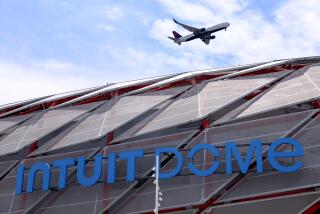Capitol Journal: AT&T and Verizon want free rein to put new wireless transmitters in your neighborhood. Here’s why that’s a bad idea
- Share via
Reporting from In Sacramento — There’s a classic brawl raging in the California Legislature between a bankrolling private interest and several toothless local governments over wireless expansion.
It’s a fight being waged essentially under the radar. This subject isn’t sexy like a gas-tax increase, universal healthcare or a so-called “sanctuary state” for immigrants here illegally. So it hasn’t gotten much public attention.
That’s when special interests tend to win.
This battle involves the big telecommunications companies — AT&T, Verizon and the like — trying to push aside local governments and start installing the next generation of wireless infrastructure without pesky interference from city hall or the courthouse.
The telecom corporations want to streamline permitting and reduce costs for slapping their transmitters — ranging in size from a pizza box to a small refrigerator — on municipal utility poles, street lights and traffic signals wherever they want.
The industry anticipates installing 30,000 to 50,000 of these “small cells” in the next few years as it rolls out the next generation of wireless networks, 5G. It will be faster and have more capacity than what we’ve got today.
But today, local governments control where the equipment is placed, usually on tall cell towers, which won’t be needed for the new stuff.
Under the contested bill, SB 649 by Sen. Ben Hueso (D-San Diego), local governments wouldn’t have the power to deny permits if the telecoms followed the minimum guidelines set by Sacramento.
Also, local governments have been tapping telecom outfits for $3,000 or more annually for each transmitter. Sometimes they’ve been hitting up the firms for a little extra kickback, such as connecting the local library to wireless. None of that would be allowed under SB 649. And the maximum per year lease on a small cell would be $250.
Local governments are aghast.
“They’d get to deploy their equipment on their own terms wherever they wanted to deploy it,” says Rony Berdugo, lobbyist for the League of California Cities. “It would force counties and cities to lease their public property for wireless equipment. And it would eliminate negotiated leases.
“We now have discretion,” Berdugo continues. “We can say, ‘We don’t want it on this pole; put it on another pole. Make your equipment the same color as the pole.’ They could put up something the size of a refrigerator on a street light by your front yard. We don’t want refrigerators on poles outside people’s windows.”
Local citizens wouldn’t have a meaningful say. There’d be no public input. It would be strictly Sacramento’s call.
The telecom companies, however, are concerned that the current permitting process would bog down expansion of broadband capacity as demand explodes. Already, they say, there are more wireless devices in California than people.
In many communities, they contend, the regulations and lease fees for wireless infrastructure are ancient, created when 200-foot towers were the norm. Some towns refuse to allow small cells on utility poles and other structures, they argue. The bureaucratic process is too lengthy, they add, and the current fees are “extreme.”
The telecom giants already have thrown up the white flag in the face of one group that tends to be wealthy and politically connected: beach dwellers. Coastal zones — narrow strips along the waterfront — are exempt from the bill, as are historic districts.
So someone who lives in Malibu might be able to beat back the visual blight of a refrigerator-size contraption. But forget it if you’re in Montebello.
In Sacramento, the telecoms have hoards of money to fuel legislators’ reelection campaigns, and they routinely spend it.
During the last election cycle, AT&T doled out more than $1.6 million to political groups and politicians. It didn’t discriminate among parties. Virtually everyone got a piece. The California Democratic Party was given $615,000. But the Republican Party got even more, $625,000.
AT&T also spent $250,000 on the annual Speaker’s Cup golf tournament at the world-class Pebble Beach course. That’s the Assembly Democrats’ big fundraiser.
By contrast, the League of California Cities and other local government organizations aren’t allowed to spend a dime on politicians because their money comes from taxpayers. They do lobby, however.
In matchups like this, the money-doling special interests usually win when only a few people are paying attention. They often lose if the public opens its eyes and gets irritated. Then the politicians respond to their constituents.
Hueso’s bill breezed through three Senate committees and the full Assembly in less than two months. There was only one “no” vote, from Sen. Steve Glazer (D-Orinda).
The measure cleared its first Assembly committee on a 6-2 vote — the two “no” votes were from Democrats — and is scheduled to be considered by the Communications and Conveyance Committee on Wednesday.
This is the kind of bill you’d expect Gov. Jerry Brown to veto, based on his rhetoric advocating local control. He’s fond of the word “subsidiarity,” meaning governance should be handled locally rather than by central powers, such as Sacramento. But Brown is unpredictable.
You can’t blame the telecoms for wanting to kick locals in the rear and expedite the permitting process for expanding broadband. But they shouldn’t be allowed to ignore local citizens. And they should pay a fair price for hanging their machinery on public property.
People should not be forced to stare at ugly refrigerators dangling outside their homes.
To read this article in Spanish, click here.
Follow @LATimesSkelton on Twitter
ALSO
Bored by state races, young Californians increasingly forsake their right to vote
More to Read
Get the L.A. Times Politics newsletter
Deeply reported insights into legislation, politics and policy from Sacramento, Washington and beyond. In your inbox three times per week.
You may occasionally receive promotional content from the Los Angeles Times.











